Kitchen faucets and bar faucets play a crucial role in the kitchen. In fact, it’s almost impossible to do without a kitchen faucet in your kitchen.
Recent data from Fortune Business Insight shows a significant growth in the kitchen faucet market size. According to the report, the projected growth trend will rise to over USD 9611.6 Million by 2025.
The same report also suggests that recent growth is related to the demand for convenience embedded with savings. Consumers are leaning toward trendy modular faucets.
But how do you determine what is best for you? You may not be sure if the traditional, contemporary, or other styles fit you.
It would be a complex scenario when you don’t know what you need owing to the limited information. My summarized guide would be an excellent place to begin a search for answers.
Here we try to dissect the two faucets and highlight the pro and cons of each. Digging in would equip you with much of what you need to know about them.
With this information, you can pride yourself on making a better decision
JUMP TO: Table Of Comparison | Bar Faucet | Kitchen Faucet | Differences Between Bar and Kitchen Faucet | Bottomline |
- Kitchen faucets are larger than bar faucets
- Kitchen faucets are also more diverse in usage than bar faucets
- Some bar sink faucets have advanced technology that allows them to respond to voice
- Both faucets are easy to install
Quick Overview (Table of Comparison)
| Parameter | Bar faucets | Kitchen faucets |
| Size | Smaller | Bigger |
| Function | Diverse | More Diverse |
| Design | Advanced in technology | Limited variety |
| Installation | Can be installed anywhere | Limited to the kitchen |
| Height | Max. 13 inches | Can be more than 13 inches |
| Material | Brass or stainless steel | Brass or stainless steel |
Bar Faucet – Explained
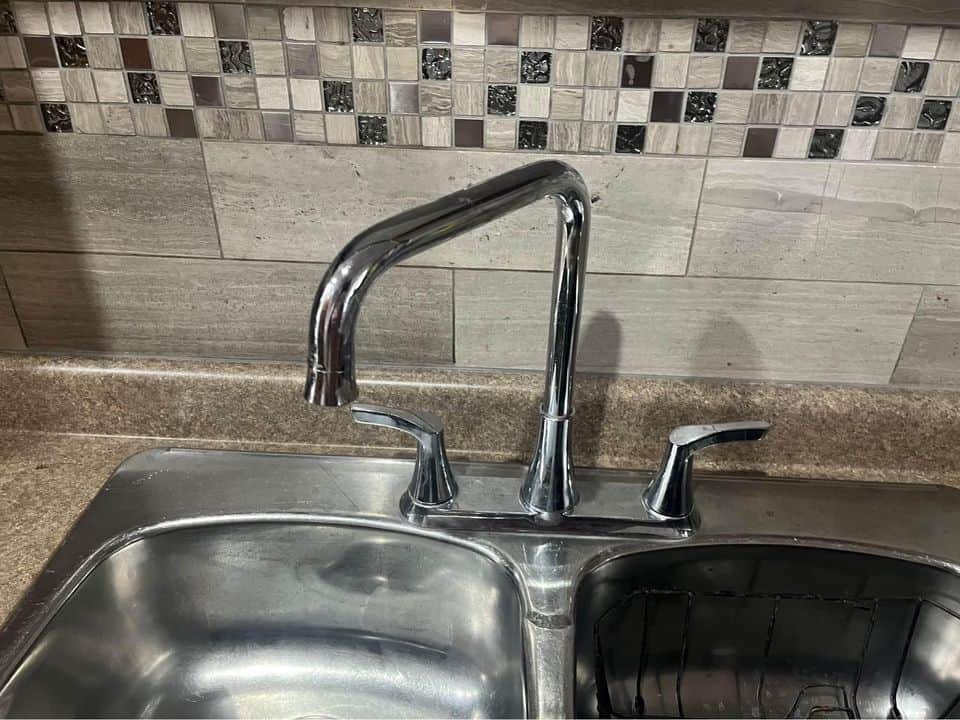
The bar faucet designer created it to fit in a smaller secondary sink. As the name suggests, this design makes an extra bar in your kitchen. It is ideal as it frees up space on the main kitchen sink and faucets.
In addition, the bar sink faucet acts as a preparation area and leaves the central kitchen for other general cleaning activities.
Bar faucets come in different sizes to meet varied consumer needs and preferences. There is almost everything for everyone’s needs.
However, the standard size between the influential brands is usually between 8 and 13 inches long.
Again, most faucets’ crafts are stainless steel or brass. Brass is more popular owing to its durability and aesthetics.
Stainless steel bar faucets are also popular among homeowners thanks to their functionality, relative durability, and reasonable pricing.
Important note: Some consumers are skeptical about brass faucets because of their association with lead poisoning.
Unfortunately, some faucet producers may not fully disclose the lead component in brass.
Pros
- Ease of installation: bar sink faucets can be installed and mounted easily anywhere, including in your kitchen or hallway.
- Takes up little space: because of the small size, they use minimal counter space.
- Style: most bar sprouts designs come in the latest stylish design and a range of colors
- Added value: with the fashionable and pricey design of the bar sprouts, your home gets an upgrade in value.
- Easy cleaning: owing to their smaller and compact sizes, bar faucets are easy to clean
- Versatile: They come in various sizes, locations, and material options. They can also be tailored to meet each specific customer’s needs.
- Cost: bar faucets can be purchased and installed within a reasonable budget.
Cons
- Size: bar faucets are much smaller, which decreases the water flow rate.
- Limited usage: Thanks to their small size, bar sink faucets are limited in usage within the kitchen.
Kitchen Faucets – Explained
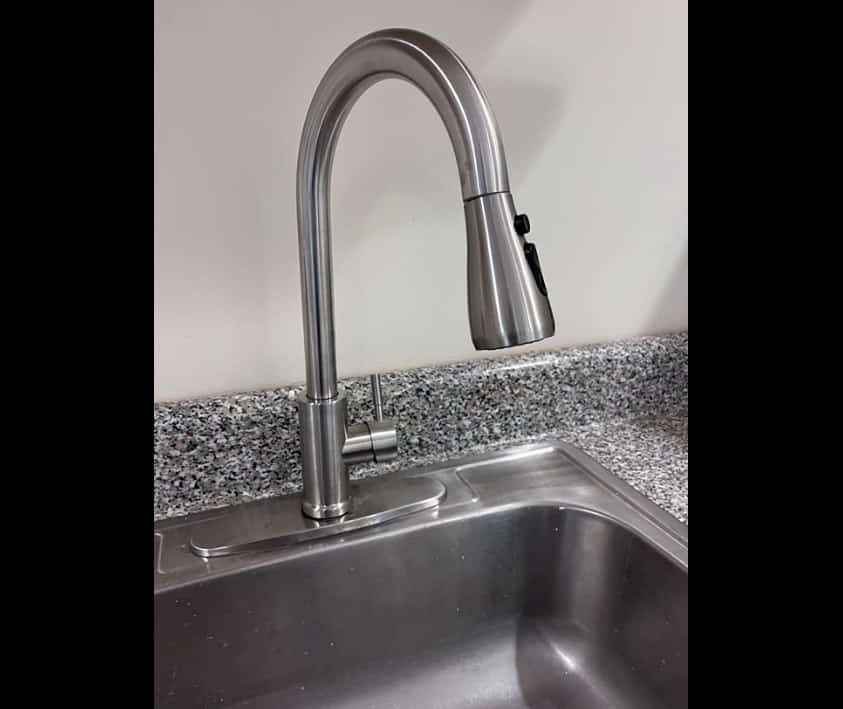
A kitchen faucet is a device that controls the water flow around the kitchen sink. Parts of kitchen sink faucets may include the water spouts, the controls, the flanges, and the creators.
The taps are usually attached to the kitchen sink using special screws. The type of screw depends on the type of faucet you may prefer.
The kitchen faucet design fits the larger kitchen sinks. The size and design of the kitchen faucets vary with different manufacturers.
The good news, however, is that an array of designs is available to meet diverse consumer needs.
A kitchen faucet either has one rotating handle or two handles. The one-handle designs control water temperatures by rotation, while the two-handle design mixes cold and hot water.
In addition, kitchen faucets may be the pullout or pull-down sprayers or stream options. The choice of faucets depends on your need and your budget.
You may choose high, low, pot filler, and swivel design types.
Also Read: How to Increase Water Pressure In My Kitchen Sink?
Pros
- Large sizes: the large sizes of kitchen faucets make way for a high-water flow rate.
- Diversity: kitchen sink faucets come with multiple functions. For example, some have an extra water sprayer sprout.
- Easy installation: the sink faucets are easy to install and come with easy-to-read manuals.
- Easy to repair: Kitchen faucets require very minimal maintenance and are easy to repair.
- Convenient to use: If you have two-handle kitchen faucets and one handle breaks, you can still use the second handle.
Cons
- Cleaning: the elaborate design of some kitchen faucets may limit their cleaning. These unreached areas may harbor bacteria that get into the kitchen sink and utensils and contaminate them.
- Challenging to install: Installing kitchen faucets with two handles is relatively tasking compared to a one-handle faucet.
6 Differences Between Kitchen Faucets and Bar Faucets
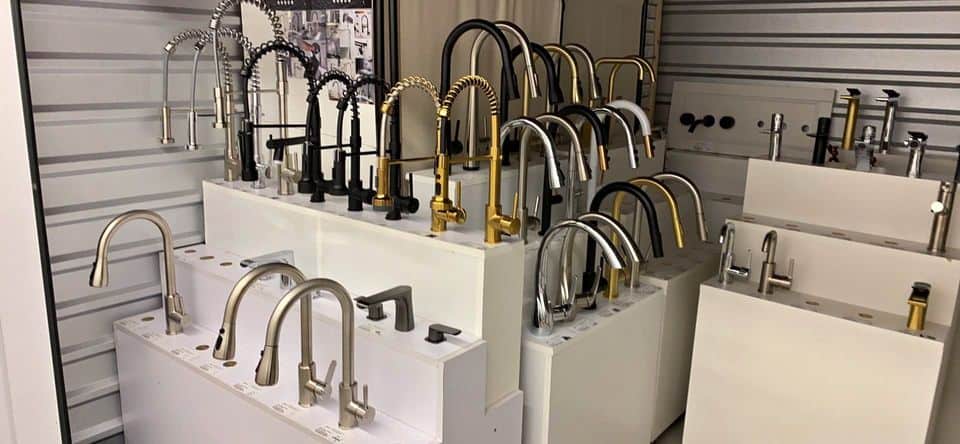
Size
Kitchen faucets are generally larger than bar sink faucets, which allows for incorporating larger kitchen sinks.
Moreover, the bigger size lets more water flow to the kitchen sink easily and faster.
On the other hand, the bar sink faucet is significantly smaller than the kitchen faucet. The pressure and the water flow rate of these faucets are low. Consequently, they fit for the use of smaller sinks with minimum spillage.
Verdict: The kitchen faucet is a clear winner here. The extra space allows for easy working, especially on oversized items.
Sprout Reach (height)
The height of kitchen faucets is crucial because it allows you space to move easily beneath them as you wash.
A bar faucet will project above your counter for a maximum height of 13 inches. However, most bar faucets have an average height of nine inches.
On the other hand, kitchen faucets can extend to a height ranging from eight to more than thirteen inches. But this is not true for all models since some have heights of 5.5 inches.
Notably, you can easily adjust the height of many kitchen faucet models.
On average, kitchen faucets are 1.75 inches taller than bar sink faucets across the brands and designs in the market.
You can get the height by measuring the distance between the faucet mount point to the highest fixed end.
Verdict: Kitchen faucets take the lead here. They have a higher height that allows for extra working space below them.
Installation
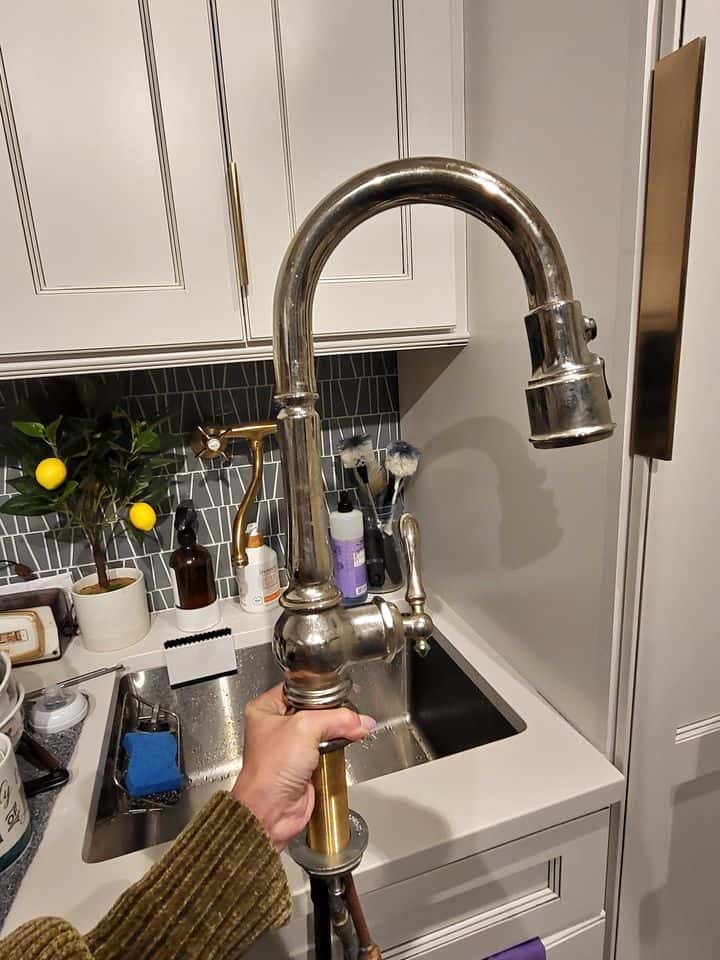
Whether installing a new faucet or replacing an old one, you don’t need to call a plumber.
The installation process of both kitchen and bar faucets is relatively easy. All you need are a few tools.
However, it differs from one design to another. In addition, each faucet type comes with laid industrial standards that act as a guide on installation.
If installing the bar sink faucet, ensure the water valves are 4 inches apart. However, the valves should be 8 inches apart if you install a kitchen faucet.
Important note: Always install bar faucets near the stove. This minimizes walking to the main kitchen sink.
The one thing that sets these two faucets apart is that the bar faucet isn’t limited to the kitchen. You can install it anywhere in your house, including the sitting room or the hallway.
And the most interesting bit is…
With bar faucets in the hallway or sitting room, you need not go to the kitchen to wash your fruits.
Verdict: The bar faucet is the winner in this category, thanks to its versatility. You can install it anywhere.
Design
When we talk of design, it all boils down to preference.
Faucets (both kitchen and bar) always exist in single–or double–handle.
Single-handle faucets are better suited for smaller spaces. They are easy to use since you only need one hand to operate them. They are also easier to clean.
On the other hand, double-hand faucets are suitable for larger spaces. They are relatively expensive and take more time to clean.
Caution: Double-hand faucets can be dangerous, especially to children, if they turn on only the hot handle.
So, what draws the line between a bar faucet and a kitchen faucet here?
The answer here narrows down to technology. Some bar faucets have advanced in technology, with some models able to respond to your voice to run water.
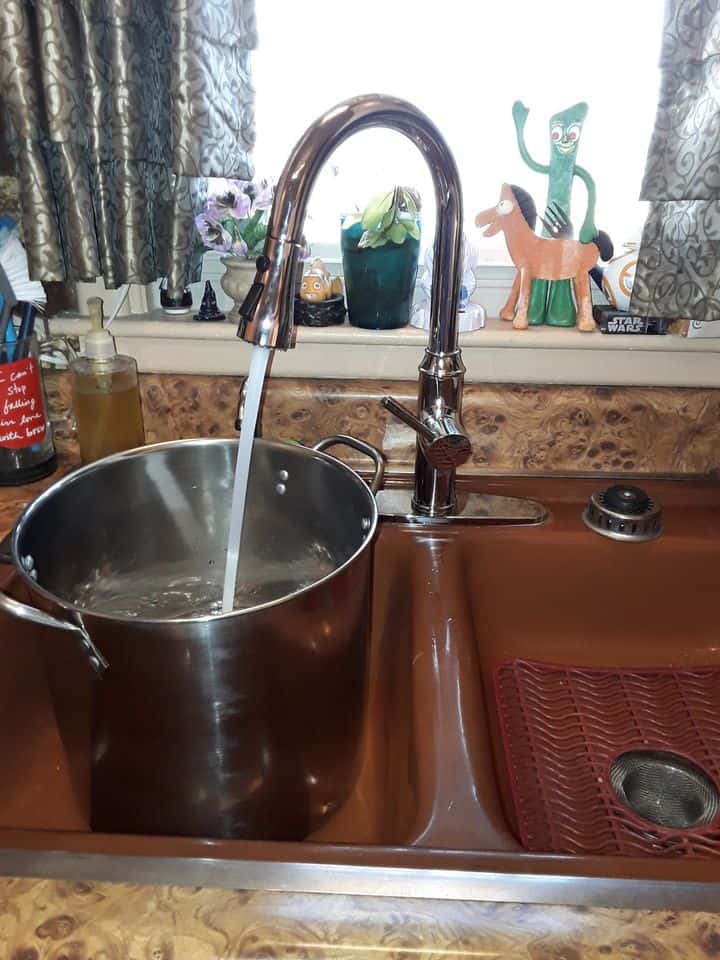
In addition, you can also instruct such faucets on what amount of water to dispense, after which it stops automatically.
Verdict: Bar faucets are the winner here, thanks to their advanced technology.
Material
Most faucets are made of brass or stainless steel. Brass is chosen for its hardness and overall durability.
Others are made of stainless steel for its easy cleaning, lightweight, and low maintenance cost. A few popular designs are made of zinc and plastic alloy but have a short usage life.
Verdict: There’s no clear winner here since the materials that make both faucets are similar.
Related Read: How to Remove Green Buildup on Faucet?
Usage and function
Do you know that the faucet is one of the busiest kitchen equipment?
The kitchen faucets and sink are used for general cleaning around the kitchen. In addition, you can use them to prep food, sanitize or cook.
Thanks to their large sizes, there is no limitation on what you can clean at the kitchen sink.
On the other hand, the bar faucet is small and can handle smaller cleaning functions. Due to the size, some larger utensils might not fit in these sinks.
Mostly, we use bar faucets for washing fruits or vegetables. We can also use a bar faucet to clean other ingredients before we cook them.
Verdict: Kitchen faucets win in this category. They have a wide variety of uses compared to bar faucets.
Wrapping it up
The significant difference between bar faucets and kitchen faucets is size. Whereas the latter is bigger, the former is slightly smaller.
However, whether you install a bar faucet or a kitchen faucet narrows down to use. Kitchen faucets are common thanks to their various uses.
The bottom line is that you can choose the best fit for your needs.
![What Are Kitchen Sinks Made Of ? [13 Types+Pros & Cons] What Are Kitchen Sinks Made Of ? [13 Types+Pros & Cons]](https://houseadorable.com/wp-content/uploads/2022/01/Sink-MAterial.jpg)
![Granite Vs. Marble Vs. Quartz Countertops [12 Differences+Pros & Cons] Granite Vs. Marble Vs. Quartz Countertops [12 Differences+Pros & Cons]](https://houseadorable.com/wp-content/uploads/2022/03/quartz-marble.jpg)
![16 Types of Kitchen Faucets Explained [With Pros + Cons] 16 Types of Kitchen Faucets Explained [With Pros + Cons]](https://houseadorable.com/wp-content/uploads/2023/02/Roca_griferia_cocina_mencia_negro_DEF_900x505_acf_cropped-1@2x-250x250.jpg)
![Centerset Vs. Widespread Faucets [8 Differences Explained] Centerset Vs. Widespread Faucets [8 Differences Explained]](https://houseadorable.com/wp-content/uploads/2023/03/1_332369605_6500081363358836_8480186754416832788_n-250x250.jpg)
![Pull Down Vs. Pull Out Faucet [9 Major Differences Explained] Pull Down Vs. Pull Out Faucet [9 Major Differences Explained]](https://houseadorable.com/wp-content/uploads/2023/04/image4-3-250x250.jpg)
![Chrome Vs. Stainless Steel Faucets: [An In-Depth Analysis] Chrome Vs. Stainless Steel Faucets: [An In-Depth Analysis]](https://houseadorable.com/wp-content/uploads/2023/03/51gDGcVWBL._AC_UF10001000_QL80_-250x250.jpg)
![Kitchen Faucet Size Chart- How to Choose?[Explained] Kitchen Faucet Size Chart- How to Choose?[Explained]](https://houseadorable.com/wp-content/uploads/2023/02/GettyImages-625163492-ee80e432c0214172a3efc97f4533a615-250x250.jpg)
![Granite vs. Quartz Countertops [Pros & Cons+6 Key Differences] Granite vs. Quartz Countertops [Pros & Cons+6 Key Differences]](https://houseadorable.com/wp-content/uploads/2022/01/Copy-of-HouseAdorable.com-1.jpg)